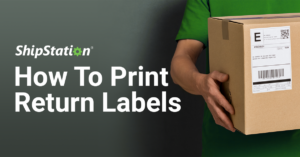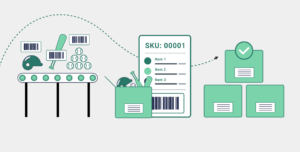Recent Posts
- AI in Marketing: The New Frontier in Logistics
- Embracing the Omnichannel Revolution in Retail
- How to Print Return Labels
- Resolving Delivery Issues in the Digital Holiday Era: A New Strategy for Retailers
- Identify the Best Selling Platforms to Boost your Peak Season Impact
- Holiday Shopping Trends 2023: Insights into expected consumer behaviour
- Australian consumers set to spend $4.8 billion on online marketplaces this ‘peak’ season
- ShipStation’s High-Volume Plan
 Featured
Featured
AI in Marketing: The New Frontier in Logistics
Artificial intelligence (AI) is moving from an emerging technology to an essential ecommerce business tool. Unlike other newer technologies, such as blockchain or the metaverse, AI directly enhances the customer journey by tailoring and streamlining shopping experiences. This blog, inspired by Shipstation’s Ecommerce Delivery Benchmark Report 2024, will delve into how AI is transforming retail logistics, helping businesses streamline operations and enhance customer interactions. As we see a merger of digital and physical shopping realms, with 75% of shoppers weaving…
 Shipping Basics
Shipping Basics
Embracing the Omnichannel Revolution in Retail
Omnichannel retail is reshaping the way we shop, blending technology with changing consumer habits to create a seamless buying experience. A recent report by ShipStation reveals that this approach allows customers to switch between online and in-store purchasing effortlessly, marking a significant shift in the retail landscape. A striking example of this shift is the […]
by Aldo Jimenez Ramirez Shipping Basics
Shipping Basics
How to Print Return Labels
A seamless returns process not only delights your customers but also transforms them into loyal patrons for life. The secret? Meeting and exceeding customer expectations. Today’s shoppers demand simplicity and convenience, especially when it comes to returns. Fortunately, we have tools and options at your disposal to streamline this process without draining your resources. By […]
by Aldo Jimenez Ramirez Holiday
Holiday
Resolving Delivery Issues in the Digital Holiday Era: A New Strategy for Retailers
In a year where online holiday spending is set to reach $389 billion, the season becomes a challenge for many e-commerce retailers to resolve delivery issues innovatively. ShipStation’s Peak Season Report 2023: Building a risk-resistant ecommerce strategy steps in as more than just a guide; it’s a strategic toolkit for retailers to excel in this […]
by Aldo Jimenez Ramirez Holiday
Holiday
Identify the Best Selling Platforms to Boost your Peak Season Impact
Spotting best selling platforms and utilising them relevantly has emerged as a critical driver of success for retailers, especially during the bustling peak season. We’ve done the research for you, and data appoints marketplaces as the preferred channel to shop online, according to global consumers. Why? Among many reasons: they offer a breadth of products […]
by Aldo Jimenez Ramirez Holiday
Holiday
Holiday Shopping Trends 2023: Insights into expected consumer behaviour
As the clocks tick closer to the festive season, both consumers and retailers are gearing up for the annual shopping bonanza. Yet, 2023 isn’t just any ordinary year; it’s one where lessons learned from the past and the expectations of a digitally savvy consumer meet. From the nuanced shopping behaviours of different age groups to […]
by Aldo Jimenez Ramirez Case Studies
Case Studies
Australian consumers set to spend $4.8 billion on online marketplaces this ‘peak’ season
New research from ShipStation and Retail Economics suggests that Australians will spend more on online marketplaces as they look for the best discounts and deals, amid a cautious economic backdrop Australian consumers look set to spend $4.8 billion this year on online marketplaces this Black Friday and Christmas as they look to get the most […]
by Aldo Jimenez Ramirez Shipping News
Shipping News
ShipStation’s High-Volume Plan
The fashion, jewellery, and accessory industries are highly competitive. The same goes for the ecommerce space. You’ve established a customer base and founded a highly successful business within your industry. It’s time to choose a shipping solution to streamline your fulfilment process. ShipStation provides high-volume shippers with automation tools and integration so that orders can […]
by Aldo Jimenez Ramirez Shipping Basics
Shipping Basics
ShipStation High-Volume: Introducing Shipping Strategies & Auto-Split
Keeping up with the demands of enterprise parcel delivery is challenging. With so many moving parts, constant changes to shipping services and label fees, plus staying on top of processing speeds all cut into fulfilment time. This is why ShipStation has built Shipping Strategies and Auto-Split. These automated features let you keep up with the […]
by Aldo Jimenez Ramirez Case Studies
Case Studies
Impact of delivery experiences on consumer attitudes
81% of Australian consumers are unlikely to buy from retailers following a negative delivery experience New ShipStation research reveals the impact of delivery experiences on consumer attitudes New research reveals the extent of negative delivery experiences on customer loyalty, with 81.4% of Australian consumers stating they are not likely to shop with a brand again […]
by Aldo Jimenez Ramirez Selling Channels
Selling Channels
What is Dropshipping and what are the pros and cons?
The traditional ecommerce practice of selling items that you keep in your warehouse or storefront is not the only way to become a successful ecommerce merchant. Some people have successful businesses that never even see the items they sell. This is known as dropshipping. Dropshipping is a business model where the person selling the item […]
by James Waite Carrier Rates
Carrier Rates
Shipping Software vs Shipping API: Which is right for my business?
Both a shipping software and a shipping API have the same end goal: creating shipping labels. Discover which shipping technology is right for your business.
by James Messer Shipping News
Shipping News
3 Biggest Myths of Sustainable Ecommerce Packaging Debunked
We are debunking the three biggest myths around sustainable packaging and what this means for ecommerce vendors.
by Guest Poster